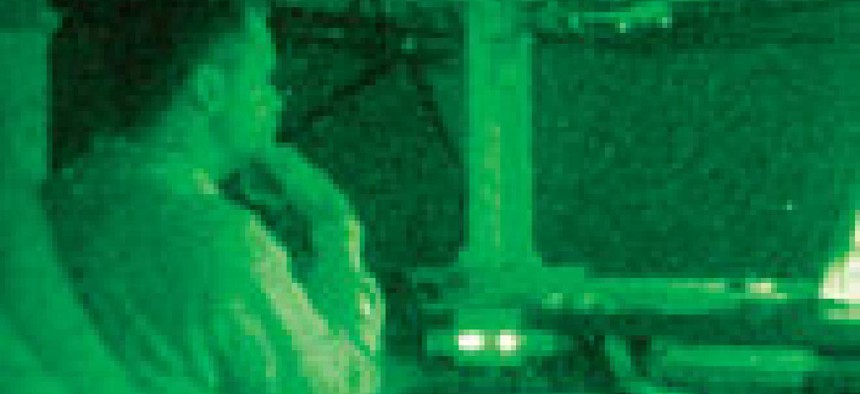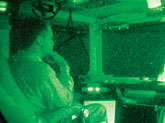Terrorism war tests DOD's capacity for data sharing


Connecting state and local government leaders
As recently as the Gulf War, military communication systems did not speak to one another. But in Afghanistan, the services are equipped with interoperable IT systems that increase the power of information by sharing it.

Navy communications and navigation systems can be linked by a secure LAN to desktop and notebook PCs.
'These MILSATCOM systems ensure that forward-deployed units have communications connectivity with their higher commanders, who can reach back to our National Command Authority,' Siomacco said.
The Global Command and Control System creates a common operating picture, a view of all friendly assets and enemy forces on a battlefield that gives military brass the information to make quick, effective decisions. The Defense Information Systems Agency manages the joint program.
Partway there
Many applications feed the picture, including joint mapping, management tracking, and communications with external systems and sensors.
Each service branch has its own implementation of GCCS that can interoperate at some level.
During the military action in Kosovo, joint commanders could not view a common operating picture, according to a recent report issued by the General Accounting Office.
Even now 'there may be instances that certain service systems have issues of passing information between the service-unique system and joint GCCS,' Navy spokeswoman Lt. Pauline Storum said. 'This is being actively worked on by DISA, the Office of the Secretary of Defense, the Joint Staff and the services.'
'A timely common operating picture is a critical combat power enabler in that it allows us to track both enemy and friendly force movements in near-real time,' Storum said. 'This enhanced visibility of the battlespace is then used to direct and synchronize our forces using the best course of action to meet our mission objectives and to counter enemy activities.'
That rosy picture is possible, although not to the degree that top Defense officials would like.
The military has made significant strides in using IT in Defense operations, said recently retired Army Gen. Mike McDuffie, who is now vice president of federal programs for the government markets unit of Global Crossing Ltd. of Bermuda. That's especially timely, McDuffie added, because the need for network-centric operations has taken on a new urgency.
Collaborate, integrate
'The more you can create a collaborative environment [for] all that are participating, the percentage [of users] that you're gaining could increase exponentially,' McDuffie said.
Defense officials have said there are new systems with which the military branches can integrate their operations through common hardware and software. The systems allow joint targeting, strike coordination and sharing of logistical data.
Experts add that Web protocols are becoming more vital to military operations.
'More and more, all of these applications that the warfighters use are being driven by Web technology,' said Phil Dixon, a former Air Force intelligence officer and now the regional sales manager for Defense and intelligence at BMC Software Inc. of Houston.
Dixon said Internet technology is making it easier and more cost-effective to move information.
'It's important in peacetime efforts also. Our military is built on information,' he said. 'Readiness relies on systems being up and running and ready.'
Still, more can be done, many Defense officials say. And since Sept. 11, more is being done.
Sharing boosts accuracy
Air Force Maj. Gen. Daniel P. Leaf, director of operational requirements and deputy chief of staff for air and space operations, said he has seen a push toward linking data and sharing imagery, areas that offer greater flexibility and accuracy.
'There is a compelling need,' Leaf said. 'American men and women are at risk in combat.'
For example, Leaf said, if a reconnaissance platform such as the Joint Strategic Target Attack Radar System identifies a building as a target, there are two ways to pass that information to attack aircraft: transmitting it over the radio for aviators to enter into their computers, or transmitting it from machine to machine.
With data linking, a sensor platform using J-STARS would capture the information and feed it to a cockpit display.
'It decreases the time required and limits the potential for errors,' Leaf said.
That could be crucial during the long war the military is preparing for, Leaf said. Also crucial is the military's ability to pass information quickly to other federal, state and local agencies.
In addition to focusing the power of friendly forces, effective and rapid information sharing can help reduce civilian casualties and other collateral damage, officials said.
'Joint [command, control, communications and computers] technologies and capabilities are crucial in coordinating air operations against enemy positions while preventing fratricide of friendly coalition forces and ensuring that innocent, noncombatant life and property are not injured or destroyed,' the Army's Siomacco said.
NEXT STORY: 23 e-gov projects to fight for funds




